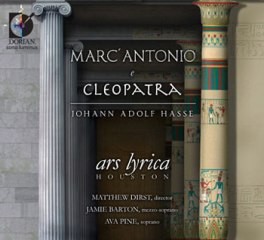Hasse - Marc' Antonio e Cleopatra (2010)
Hasse - Marc' Antonio e Cleopatra (2010)

CD1 01. Sinfonia: Spiritoso e staccato - Allegro 02. Sinfonia: Spiritoso e staccato - Grazioso 03. Recitativo: Da quel salso elemento 04. Aria: Pur ch'io possa a te (Marc' Antonio) 05. Recitativo: Signor, la tua sciagura 06. Aria: Morte col fiero aspetto (Cleopatra) 07. Recitativo: Or che la mia fortuna 08. Aria: Fra le pompe peregrine (Marc' Antonio) 09. Recitativo: Si, mel rammento, o caro 10. Aria: Un sol tuo sospiro (Cleopatra) 11. Recitativo: Cosi rapido fugge e vola il tempo 12. Duetto: Attendi ad amarmi (Marc' Antonio, Cleopatra) CD2 01. Recitativo: Signor, la tuna speranza 02. Aria: A Dio trono, impero a Dio (Cleopatra) 03. Recitativo: Ah, tolga il ciel mia cara 04. Aria: Come veder potrei (Marc' Antonio) 05. Recitativo: Lascia, Antonio, deh lascia 06. Aria: Quel candido armellino (Cleopatra) 07. Recitativo: L'eroico tuo coraggio 08. Aria: La tra i mirti degl'Elisi (Marc' Antonio) 09. Recitativo: Poiche la morte sola 10. Duetto: Bella etade avventurosa (Marc' Antonio, Cleopatra) Cleopatra - Ava Pine Marc'Antonio - Jamie Barton Ars Lyrica Houston Conductor - Matthew Dirst
Like Handel had done some years earlier, Johann Adolf Hasse left his native Germany in 1721 to gain some Italian polish, He eventually settled in Naples and studied with Porpora and Alessandro Scarlatti. In 1730 he moved to Dresden where he became Kapellmeister, married one of Handel's divas and the two became the power couple of late baroque opera.
During his Italian period Hasse produced seven operas, eight intermezzi and the serenatas. His serenata Marc'Antonio e Cleopatra was written for a Neapolitan banker in whose palace it was first performed in 1725. As a genre the serenata lay somewhere between the solo cantata and a full-length opera. Typically baroque serenatas set a familiar love story and form a sequence of short operatic scenes. Here the libretto is by poet and impresario Francesco Ricciardi. It starts with Marc'Antonio's defeat by Octavian, the two declare their love and rather than submit to Rome, agree on suicide.
But there is an element in the original casting which sheds a fascinating light on the difference between baroque attitudes and ours. The original singers were the castrato Farinelli and the contralto Victoria Tesi, but contrary to what we might expect Farinelli sang Cleopatra and Tesi sang Marc'Antonio. Such cross-casting was then common in Italy, as it helped emphasise the artificiality of the operatic genre. But castrati did not sing travesty roles in England, so we are less familiar with the idea.
On this recording from Ars Lyrica Houston, the two roles are sung by women with Jamie Barton as Marc'Antonio and Ava Pine as Cleopatra.
The serenata opens with a sinfonia with each half being formed from four arias and a duet. Each singer is allocated the same number of arias, preserving perfect balance. But in another respect there is a difference. The role of Marc'Antonio (originally sung by Tesi) has a sequence of lyric, galant arias but Cleopatra (sung by Farinelli) is given a sequence of wonderfully brilliant arias. It is Cleopatra which is the show-piece role. Hasse became renowned for delivering virtuoso arias which showed off and flattered the original singers’ voices.
Pine has quite a rich voice, she is no slim-voiced canary, but displays a lively sense of baroque style and is quite fearless in her way with Hasse's virtuosic vocal lines. She makes a strong, commanding queen. Barton has a Marilyn Horne-like voice and a nice way with the lyrical lines which Hasse has written for Marc'Antonio. Though there are moments when she sounds a little too careful, she is suitably love-lorn.
The piece is quite short, lasting a fraction under 90 minutes. But I did wonder whether the piece might have been fitted onto a single CD. Conductor Matthew Dirst takes the recitatives at an amazingly sedate pace, they are sedate and deliberate rather than dramatic; you certainly wouldn't want to hear an entire opera performed this way.
The serenata became quite famous in Hasse's lifetime, but this seems to be its first complete recording, so we must be thankful to Ars Lyrica Houston. It is an attractive and well made piece, but it does not mine the real depths of the characters’ emotions the way Handel could. Handel's Italian period produced such striking gems as his cantata Lucrezia which explores Lucrezia's emotional turmoil in depth; whereas Hasse seems to have been mainly concerned to show off his singers in the best light and perhaps flatter the audience.
Hasse's original accompaniment was for strings and continuo but Ars Lyrica have added some woodwind (oboes, recorders, flute and bassoon) to produce a rather effective piece. That said, you do wonder whether Hasse's original slimmer version might have been tighter and more dramatically incisive.
Under Matthew Dirst's capable direction Ars Lyrica and their soloists give a lively performance of a charming work. It brought fame to Hasse and is well worth encountering in this engaging performance. ---Robert Hugill, musicweb-international.com
download: uploaded anonfiles mega 4shared mixturecloud yandex








